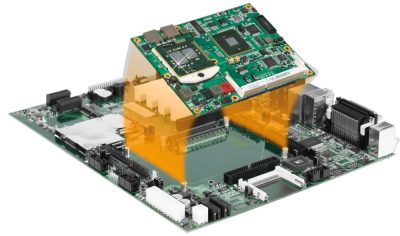
Computer-on-Modules are highly integrated CPU boards that are used on board a housing board, called a carrier board, which integrates the ports and connectors required for communication with input and output devices. Unlike traditional single-board-computers, in fact, computer-on-modules are equipped with connectors that serve only and exclusively to transfer CPU signals to the housing board, whether standard or developed specifically by the customer. This approach allows to "separate" the PC architecture into two completely independent parts: the field electronics (carrier-board) and the microprocessor processing (Computer-on-Modules).
The modular approach guarantees a series of advantages that materialize throughout the entire life cycle of a project. Starting from ETX, considered the first true standard for Computer-on-Modules, the market has in fact witnessed a continuous growth, seeing new standards arise over the years, including COM Express, Qseven and SMARC, each with its own peculiarities. Embedded electronics projects can be extremely heterogeneous depending on the type of application and the related area of use. However, there are common problems that arise from a series of factors that harmonize many of the needs of electronic designers. We can therefore affirm that each embedded project is united by a series of common problems to which the Computer-on-Modules can respond in an efficient manner.
In the first place, the growing drive to contain development and production costs is a push towards the use of Computer-on-Modules. In industrial projects in fact the complexity of modern x86 processors often clashes with low production volumes that do not justify the development of full-custom electronics starting from the microprocessor. The projects also require an increasingly reduced time-to-market, further pushing companies towards the use of COTS (commercial-of-the-shelf) products that guarantee a good level of customization. From this point of view the Computer-on-Modules represent the optimal choice as they guarantee the maximum customization at the level of the carrier-board exploiting, at the processing level, CPU modules ready for use. They also guarantee a greater speed of project implementation as the availability of "starter-kits" allows immediate hardware and software development.
Compared to the use of single-board-computers, the modules leave ample room for the designer for the possible implementation of functions and interfaces outside the classic PC world (eg FPGA, DSP, Fieldbus, motion control etc.) allowing designers to focus on their know-how, the true added value of each company. The Computer-on-Modules are also real open industry standards managed by consortia that dictate the specifications guaranteeing interchangeability from manufacturer to manufacturer. This allows designers to exploit an entire ecosystem of suppliers, guaranteeing purchasing departments the possibility of reducing risk and dependence on the supplier thanks to the many possible sources of supply. At the moment there are two consortia that regulate the various standards: on the one hand SGET (Standardization Group for Embedded Technologies) which includes the SMARC and Qseven standards and on the other hand PICMG (PCI Industrial Manufacturers Computer Group) to which the COM Express standard belongs.
The Computer-on-Modules market is solid, growing and supported by all the major companies in the industrial sector that allow the immediate exploitation of the state of the art of technology. Thanks to direct partnerships with companies such as Intel, AMD and NXP in fact the Computer-on-Modules manufacturers have privileged access to the new CPUs, allowing customers to be able to take advantage of these technologies as quickly as possible. The continuous development of new modules by the manufacturers allows then to maximize their investment having the possibility to exploit new generation modules without having to change the carrier-board. This also allows for easy upgrades and downgrades of the project without charges as the Computer-on-Modules offer scalability upwards and downwards within the same standard. Taking advantage of the same carrier-board, the designer has the possibility of creating multiple product variants in terms of performance by using modules of different classes.
From a technical point of view, there are different standards for Computer-on-Modules, each with its own peculiarities. Today the main market standards are COM Express with its variants, Qseven and SMARC. In the next articles we will analyze the differences between the various standards and the consequent application implications.























